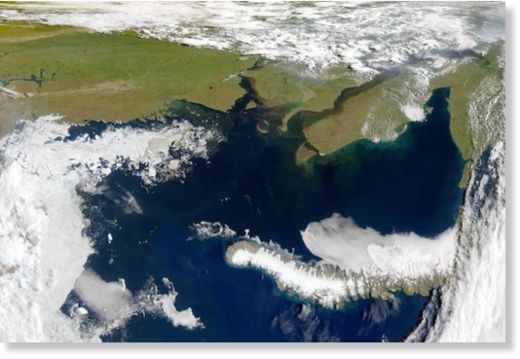Large volumes of methane being released in Arctic Ocean

© NASA
Kara Sea is a section of the Arctic Ocean between Novaya Zemlya and the Yamal Peninsula on the Siberian mainland. Siberian permafrost extends to the seabed of the Kara Sea, and it is thawing.
Researchers from Norway and Russia have found significant amount of the greenhouse gas methane is leaking from an area of the Arctic seabed off the northern coast of Siberia.
According to the team's report in the , the melting of permafrost on the seafloor of the Kara Sea is releasing previously-sequestered methane.
"The thawing of permafrost on the ocean floor is an ongoing process, likely to be exaggerated by the global warming of the world´s oceans," said study author Alexey Portnov at Centre for Arctic Gas Hydrate, Climate and Environment (CAGE) at The Arctic University of Norway.
Permafrost is considered soil that has been permanently frozen for at least two years and is usually much thicker on land where temperatures can stay far below the freezing point for months on end.
"Bottom water temperature is usually close to or above zero. Theoretically, therefore, we could never have thick permafrost under the sea," Portnov explained.
He added that 20,000 years ago, during the last ice age, the sea level dropped nearly 400 feet.
"It means that today´s shallow shelf area was land. It was Siberia. And Siberia was frozen," Portnov said. "The permafrost on the ocean floor today was established in that period."
When the last ice age ended around 12,000 years ago, the Kara Sea became submerged by water - kicking off a slow thaw of the previously-terrestrial permafrost. While previous research has shown that this permafrost extends down around 330 feet, the new study has found evidence of methane leaking from much shallower depths - between 66 and 100 feet.
"The permafrost is thawing from two sides," Portnov said. "The interior of the Earth is warm and is warming the permafrost from the bottom up. It is called geothermal heat flux and it is happening all the time, regardless of human influence."
Using mathematical models based on expected conditions, the study team concluded that the maximal possible permafrost thickness would take around 9000 years to thaw. If Arctic Ocean temperatures were to increase due to global warming, the process would accelerate, the researchers noted.
"If the temperature of the oceans increases by two degrees as suggested by some reports, it will accelerate the thawing to the extreme," Portnov said. "A warming climate could lead to an explosive gas release from the shallow areas."
In addition to containing methane in seafloor sediments, permafrost also serves to stabilize ice-like structures called gas hydrates that form under high pressure and low temperatures.
"Gas hydrates normally form in water depths over 300 meters (980 feet), because they depend on high pressure," Portnov said. "But under permafrost the gas hydrate may stay stable even where the pressure is not that high, because of the constantly low temperatures."
Gas hydrates typically contain large volumes of gas and their release would generate massive sinkholes like those currently being formed by melting permafrost on the Siberian mainland.


0 reacties:
Post a Comment